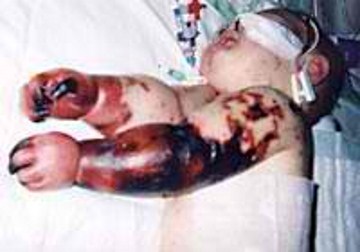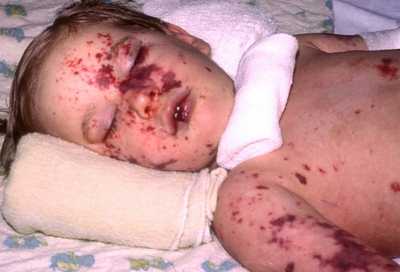Meningococcemia – Rash, Symptoms, Treatment, Pictures, Causes
What is Meningococcemia and what causes bacterial meningitis?
Meningococcemia is a kind of infection that affects the person’s bloodstream which may be due to the bacteria called as Neisseria meningitidis, which is a gram negative kind of bacteria. The bacteria is contagious in nature and has the ability to spread from one person to many through respiratory mode via the secretions or droplets.
Although meningococemia may be etioligally due to variously wide class of disease. The severest form of this syndrome is the neiserial meningitis which is often the most life-threatening disease.This kind of disease, as mentioned earlier, which is caused by neisseria meningitidis is that when one has this condition there is a great chance that it will progress into meningitis and it may also result inot dermatologic problems.

A child who has Meningococcemia
Image source: wikimedia.org
Meningococcemia Pathology
When a person is positive for menigococcemia, he or she will have the bacteria, neisseria meningitidis, which attaches to the respiratory mucosa and are taken by the phagocytes, which functions as the protector of the endothelial cells and capsule. When the bacteria reaches to this point, the bacteria will then release endotoxin which will then damage the vessels which will result to the symptoms that will be discussed further as we go along.
Meningococcemia Symptoms
The patient with meningococcemia will manifest the following symptoms:
- Arthralgia
- Myalgia
- Fever
- Petechia
- Bullae
- Hemorrhagic lesions
- Maculopapular rash lesions
- Stellate pupura with having a gray hue* late sign
- Anxiety
- Irritability
- Nausea
- Fatigue
- Chills
- Sore throat
- Vasculitis
- Muscle pain
- Headache
- Shock * late sign
- The level of consciousness changes * late sign
- Myocarditis* late sign
These are the most common symptom associated with this kind of disease condition.

Stellate pupura with having a gray hue (rash)
Image source: medlibes.com
Meningococcemia Causes
As mentioned earlier, the cause of this delibitating disease is due to neisseria meningitidis or otherwise known as meningococcus. This disease condition may also be called as meningococcal bacteremia. What happens is that the bacteria before it attacks to the entire body, will lodge in the person’s uppermost portion of the respiratory tract silently or asymptomatically. The bacteria is contagious and will affect and spread to one person to another person via respiratory mode in the form of secretions such as droplets.
Although, some persons will be affected and will show signs associated with the disease condition. However, some who are affected with the disease condition may not show signs of the disease and are often tagged as carrier of the disease condition. This carrier persons may have the ability of spreading the disease to others.
Meningococcemia Diagnosis
The physician, who are the ones capable of diagnosing the patient with meningococcemia, would suggest the patient to undergo examinations such as:
- Physical examination
- Medical history examination
- Blood culture examination
- Clotting examination
- Complete blood count examination that has differential
- Urinalysis
- Skin biopsy
- Lumbar puncture examination
The kind of examination done with the patient who are suspected to have meningococcemia will vary from person to person. Yet, the ones mentioned above are the possible examination that the patient must undergo to confirm the disease condition.
Meningococcemia Terminology
Fulminant Meningococcemia
The fulminant meningococcemia is a kind of disease condition that is rarest under the classification of menigococcal disease condition which will result to often a fatal form of the disease condition. The deterioration of this kind of disease classification may also lead to the failure of both respiratory and heart which may result to hypotension.
Chronic Meningococcemia
When a person has a chronic form of meningococcemia, it means to say that the symptoms are worsening and recurring. When one reaches this point, there will be a risk for sepsis if the condition is not well tolerated and especially if the body does not anymore respond to the treatment being given. It is a rare kind of classification of meningococcemia which occurs more often in adults. This kind of disease, because of the fact that is resembles to other forms of diseases such as vasculitis and the like thus there is a need that there should be a strong suspicion of the disease to be able to come up with the right treatment for the disease condition.
Meningococcemia Treatment
When one is diagnosed with this kind of disease condition, which is known to be a medical emergency, there should be a surveillance of the progression of the disease condition. The patients are often admitted to the intesive care unit to be able to have a close monitoring of the patient having the disease condition. It is only in the intensive care unit, wherein there is one is to one ratio of the patient to his or her nurse, which is an ideal set up especially with this disease condition. In addition to that, since this disease can be spread via respiratory secretion thus the patient has to be in isolation, specifically in respiratory isolation to prevent the spread of the infection to others. Other treatment may be done, such as:
- IV fluids
- Wound care
- Replacement of platelets or clotting factors
- Antibiotics
- Breathing support such as mechanical ventialtion or oxygen therapy
- Drugs for low blood pressure
- Corticosteroid drugs
- Surgeries can be done like:
- Periocardiocentesis for patients with pericarditis with a complication of tamponade
- Amputation for arterial occlusion
When the patient is treated early, there is a high chance that the patient will have a good prognosis and he will survive this disease condition. Hence, it is advisable that that the patient should consult a doctor as soon as possible whenever symptoms will arise. However, when the person reaches the late stages and shock may develop the chances for survival or living is poor and the outcome of the treatment will be a little less certain.
On the otherhand, with persons who are at risk for the disease condition, there is a need to have to undergo antibiotic therapy and vaccination, which is specially done in children and in older persons to prevent the spread of the disease condition. You need to talk with the doctor with the options presented in your area.
